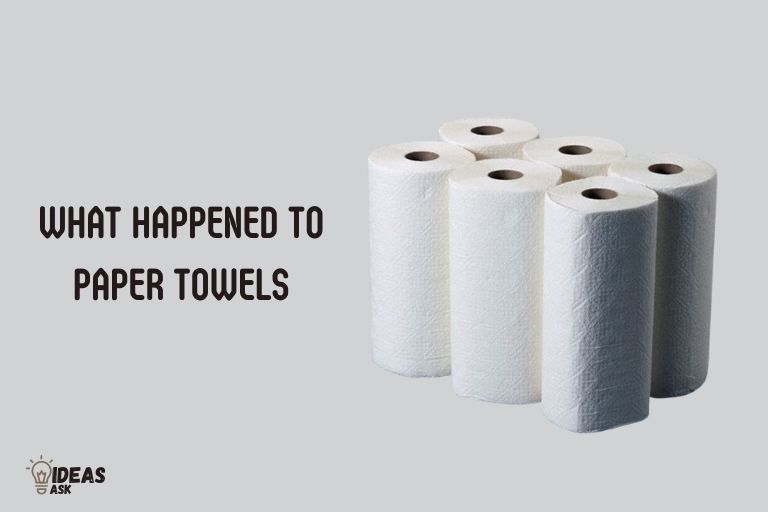What Happened to Paper Towels? Find Out!
During the COVID-19 pandemic, paper towels experienced a surge in demand as people focused on enhanced hygiene and sanitation.
This was largely due to the fear of virus transmission and the need for frequent cleaning and disinfecting.
As a result, consumers stockpiled paper towels, leading to temporary shortages in some areas. The paper towel industry adapted by increasing production, adjusting supply chains, and exploring touchless dispenser innovations to meet the increased demand.
This demand spike showcased the adaptability and resilience of the paper towel industry in response to unprecedented circumstances.

Key Takeaway
The Evolution of Paper Towels
Origins and Early Usage of Paper Towels
- Paper towels have a rich history that can be traced back to ancient China, where they were first invented around the 2nd century BC.
- The earliest paper towels were made from natural fibers, such as mulberry bark and bamboo.
- These early paper towels were primarily used for hygiene purposes, like cleaning hands and face, and were often found in wealthy households and royal courts.
Key Developments in Paper Towel Production Techniques
- Significant advancements in papermaking techniques occurred during the Industrial Revolution in the 18th and 19th centuries, which led to the mass production of paper towels.
- The introduction of wood pulp as a raw material revolutionized the industry, making paper towels more affordable and accessible.
- Innovations in paper towel production, including the development of embossing techniques, improved absorbency, and perforated rolls, enhanced their functionality and convenience.
Changes in Paper Towel Design and Materials Over Time
- Early paper towels were relatively basic in design, resembling cloth-like sheets. However, as the industry evolved, paper towel design became more varied.
- The shift from single-ply to multi-ply paper towels improved durability and absorption capabilities.
- The incorporation of recycled and sustainable materials in paper towel production reflects a growing emphasis on environmental responsibility.
The Role of Paper Towels in Household and Commercial Settings
- Paper towels have become a ubiquitous product in modern households, often used for cleaning, wiping spills, and as a convenient hand-drying option.
- In commercial settings, paper towels are widely used in public restrooms, kitchens, and various industries like healthcare and food service.
- Their disposable nature has made them a preferred choice for hygiene and cleanliness in public spaces.
Impact of Environmental Concerns
How Environmental Awareness has Influenced the Paper Towel Industry:
- Growing concerns about environmental sustainability have had a profound impact on the paper towel industry. Consumers and businesses alike are increasingly aware of the ecological footprint of their choices.
- Environmental awareness has led to increased scrutiny of the paper towel manufacturing process, from raw material sourcing to production and disposal.
- This heightened consciousness has prompted stakeholders to reevaluate their practices and strive for more environmentally responsible solutions.
Shift Towards Eco-Friendly and Sustainable Paper Towel Products
- In response to environmental concerns, the paper towel industry has witnessed a significant shift towards producing eco-friendly and sustainable paper towel products.
- Manufacturers have begun to adopt more sustainable sourcing practices, such as using recycled paper or bamboo, which are more renewable and environmentally friendly compared to traditional wood pulp.
- Eco-friendly paper towels are often produced with reduced chemicals, dyes, and bleaches, making them more biodegradable and less harmful to the environment.
Regulatory Measures and Industry Initiatives Promoting Sustainability
- Governments and regulatory bodies have imposed stricter environmental regulations on the paper towel industry, encouraging sustainable practices.
- Industry organizations and initiatives, such as the Sustainable Forestry Initiative (SFI) and Forest Stewardship Council (FSC), promote responsible forest management and sustainable sourcing of paper towel materials.
- These efforts aim to set standards and certifications that help consumers identify environmentally responsible paper towel products.
Pandemic and Paper Towel Demand
Analyze the Impact of the COVID-19 Pandemic on Paper Towel Consumption
- The COVID-19 pandemic, with its emphasis on hygiene and sanitation, had a profound impact on paper towel consumption. As individuals and businesses worldwide heightened their focus on cleanliness, the demand for paper towels surged.
- The pandemic prompted consumers to become more health-conscious, leading to an increased need for paper towels in homes, workplaces, and public spaces.
- People began using paper towels not only for their traditional roles, such as cleaning and wiping surfaces, but also for more frequent hand drying and disinfecting purposes.
Explain the Surge in Demand for Paper Towels During the Pandemic
- The surge in demand for paper towels during the pandemic can be attributed to several factors. Firstly, the fear of virus transmission led to a spike in panic buying, where consumers stockpiled essential items, including paper towels, as a precautionary measure.
- Increased time spent at home due to lockdowns and remote work also contributed to higher usage of paper towels for various cleaning tasks and kitchen use.
- The closure of restaurants and public restrooms in many places led to a shift in consumer behavior, with people relying more on paper towels in the absence of air dryers and shared cloth towels in public spaces.
Discuss How the Industry Adapted to Meet Increased Demand
- To address the unprecedented surge in demand, paper towel manufacturers and suppliers had to adapt swiftly. They increased production and distribution efforts to meet the growing needs of consumers and businesses.
- Manufacturers ramped up production lines, operated around the clock, and even repurposed production facilities to produce more paper towels.
- Supply chain adjustments, including prioritizing essential products, implementing safety measures for workers, and ensuring a steady flow of raw materials, were crucial in maintaining the supply of paper towels during the pandemic.
- The industry also explored innovations, such as touchless paper towel dispensers, to enhance safety and reduce cross-contamination in public spaces.
The impact of the COVID-19 pandemic on paper towel consumption was significant, leading to increased demand due to heightened hygiene concerns.
The industry responded with rapid adaptations in production, distribution, and product design to meet the needs of consumers and businesses during this exceptional period.
The Future Of Paper Towels And Towel Substitutes
Predictions For The Future Of Paper Towels
As we continue to tackle the global environmental crisis, the future of disposable products such as paper towels looks bleak.
With the ban on single-use plastic, it’s only a matter of time until paper towels come under scrutiny as well.
Here are some predictions for paper towels in the future:
- The demand for paper towels will decrease as more people switch to reusable options, such as cloth towels.
- Companies will come up with innovative designs, improving the durability and longevity of paper towels.
- Governments may impose taxes on paper towel manufacturers to raise awareness and discourage people from using them.
The Challenges And Opportunities For Alternative Solutions
With paper towel usage on the decline, alternative solutions are emerging.
Challenges:
- Consumers are often resistant to change and may not immediately adopt new products or practices.
- Not all alternatives are suitable for every household, depending on location and lifestyle.
Opportunities:
- Cloth towels are a perfect alternative for those who are prepared to make the switch. They are reusable, eco-friendly, and cost-effective in the long run.
- Bamboo towels, made from bamboo fibres, are a great option for those who do not wish to switch to cloth towels; they are durable, biodegradable, and eco-friendly.
The Need For Consumer Awareness And Responsibility
In the end, it all comes down to consumer awareness and responsibility. To reduce our environmental impact, we must take responsibility for our actions and educate ourselves about the ecological effect of our daily choices.
Here are some points to keep in mind:
- Educate yourself about the pros and cons of paper towels and their alternatives.
- Consider purchasing sustainable products that can be reused.
- Encourage others to opt for eco-friendly practices and products.
The future of paper towels looks uncertain, and we must adapt our habits to achieve a sustainable future.
Let us be responsible for our actions and make a conscious effort to educate others on the importance of the decisions we make.
The Emergence Of Alternative Solutions
Paper towels have been a staple in households and commercial establishments for decades. However, the environmental impact of paper towel production and waste is becoming a growing concern.
Fortunately, alternatives are emerging to address this issue. Here, we’ll discuss the key points on the popularity of reusable towels, the trend of switching to hand dryers, and the introduction of environmentally-friendly paper towels.
The Popularity Of Reusable Towels
- Reusable towels are gaining popularity as a sustainable alternative to disposable paper towels.
- They are machine washable, which makes them more cost-effective in the long run.
- Reusable towels come in many varieties, including microfiber, bamboo, and cotton.
- They can be found in most stores and online retailers, making them easily accessible to consumers.
- Reusable towels reduce waste and environmental impact, making them a popular choice for those looking to reduce their carbon footprint.
The Trend Of Switching To Hand Dryers
- Many commercial establishments are switching from paper towels to hand dryers to reduce waste.
- Hand dryers are more hygienic as they eliminate the need for touching a communal dispenser.
- They are also more cost-effective as they only require electricity to operate.
- Hand dryers come in different types such as jet air, warm air, and high-speed models with varying drying times.
- While hand dryers have a higher initial cost than paper towels, they are a sustainable investment in the long term.
Introduction Of Environmentally-Friendly Paper Towels
- Some paper towel manufacturers are now producing environmentally-friendly paper towels.
- Eco-friendly paper towel production involves using recycled materials or sustainably-sourced materials.
- These paper towels are unbleached, reducing the amount of chemicals used in production.
- Environmentally-friendly paper towels decompose faster than traditional paper towels, reducing waste and environmental impact.
- Manufacturers of environmentally-friendly paper towels are making a significant impact in reducing waste in the paper industry.
Alternative solutions to traditional paper towels, such as reusable towels, hand dryers, and environmentally-friendly paper towels, are gaining popularity due to growing environmental concerns.
Businesses and households alike have the power to make a sustainable impact by switching to these alternative solutions.
Conclusion
Ultimately, the disappearance of paper towels from store shelves may have been a shock to consumers, but it’s clear that the pandemic played a major role.
With panic buying causing an initial shortage, production and supply chain issues continued to exacerbate the problem.
However, while it’s undeniable that the pandemic had a significant impact on the lack of paper towel availability, it also highlighted the importance of sustainability and eco-friendliness in the world today.
As society becomes more conscious of their impact on the environment, it’s likely that the popularity of paper towels will continue to dwindle as alternatives such as reusable cloth towels and air dryers gain more traction.
Regardless, it’s important for manufacturers to understand the importance of creating a sustainable and reliable supply chain that can withstand the challenges of a pandemic.
Only time will tell what the future holds for paper towels, but it’s clear that the events of the past year have demonstrated the need for adaptability and forward-thinking in the industry.





